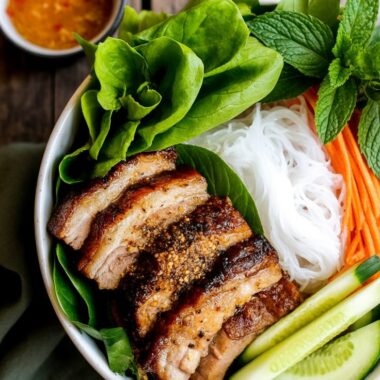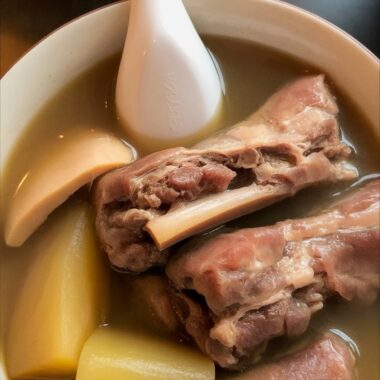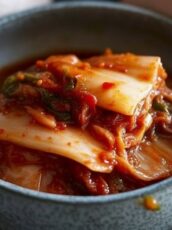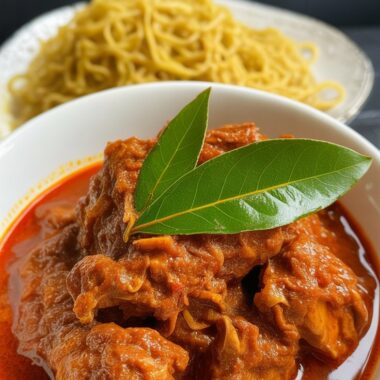There’s something incredibly comforting about a pot of slow-cooked Chicken Rendang simmering away on the stove — the spices wafting through the house, the deep aroma of toasted coconut, and the anticipation of tearing into juicy, spice-soaked chicken with your hands. This isn’t just a meal, it’s an experience. And let me tell you, this version is as close to authentic as you can get in a home kitchen.
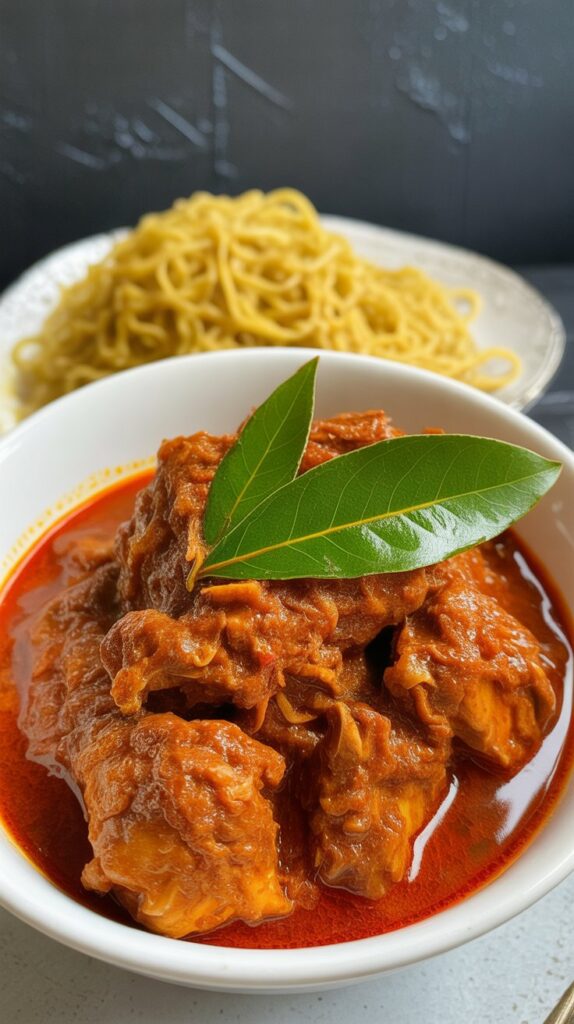
I first tried Chicken Rendang at a small Malaysian stall tucked behind a local festival years ago, and it completely changed how I thought about chicken curry. The rich, almost dry-style gravy clinging to each piece of chicken — deeply spiced but mellowed by coconut — is just unforgettable. And ever since, I’ve been chasing that same bold flavor at home.
What Makes Chicken Rendang So Special
If you’re new to Rendang, you’re in for a treat. It’s a beloved dish across Malaysia and Indonesia, and for good reason. Unlike typical chicken curries that are soupy or creamy, Rendang cooks down until the sauce is thick, caramelized, and full of character.
The magic comes from two things:
- The spice paste, packed with aromatics like galangal, ginger, lemongrass, and dried red chilies.
- The kerisik — toasted shredded coconut — which adds nutty depth and gives Rendang its signature texture.
It’s not a dish you rush, and that’s part of the charm. The flavors develop slowly as the coconut milk reduces and the chicken soaks up every bit of the spice.
Ingredients You’ll Need
Here’s what I used for this batch of Chicken Rendang. Most of these ingredients are pantry staples in a Southeast Asian kitchen, but I’ll offer a few substitutes too if you’re working with limited options.
For the Chicken Rendang:
- Chicken with bone – Bone-in thighs or drumsticks work best. They stay tender and hold flavor better than boneless cuts.
- Oil – I used a neutral oil like sunflower, but feel free to use coconut oil for extra flavor.
- Whole spices – Cloves, cardamom, cinnamon, and star anise bring warm, earthy tones.
- Lemongrass – Bruised to release its citrusy oils. If fresh isn’t available, try frozen or use a lemongrass paste.
- Coconut milk – Use full-fat for richness.
- Kaffir lime leaves – These add that bright, aromatic note that cuts through the richness.
- Freshly grated coconut – Toasted into kerisik; this adds the finishing touch.
For the Spice Paste:
- Dried Kashmiri red chilies – Soaked in hot water to soften. They give that vibrant red hue without too much heat.
- Shallots – These are sweeter and milder than onions.
- Garlic, ginger, and galangal – All fresh; galangal gives Rendang its unmistakable aroma.
- Inner white part of lemongrass – The most tender and flavorful part.
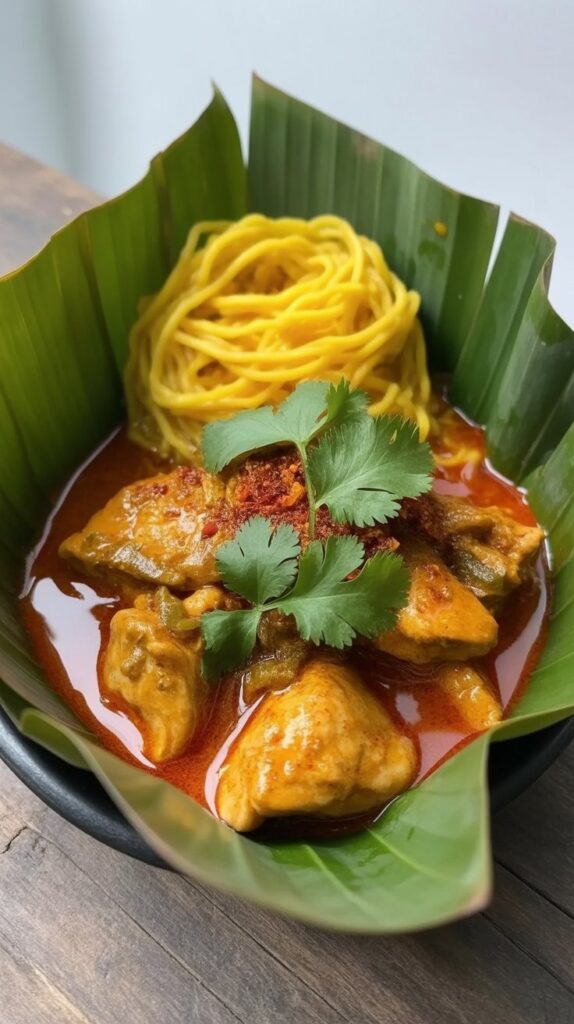
How I Like to Make Chicken Rendang at Home
Here’s how I pull everything together. It’s not complicated, but it’s a dish that rewards patience.
Step 1: Toast the Coconut (Kerisik)
Start by making the kerisik. I toast freshly grated coconut in a dry pan over medium heat until golden brown and nutty. This takes about 5 to 8 minutes. Stir often, and don’t walk away — it can burn quickly. Once golden, I like to pound or grind it just a little to release its oils and make it easier to blend into the curry later.
Step 2: Prep the Spice Paste
While the coconut is cooling, I soak the red chilies in hot water for 10 minutes to soften. Then I blend them with shallots, garlic, ginger, galangal, and lemongrass into a smooth paste. Add a splash of water if needed to get the blender going.
Step 3: Start the Rendang
In a wide, heavy pan or wok, heat oil and add the whole spices. Let them sizzle and bloom for a minute. Then in goes the spice paste. Sauté this over medium heat for 5 to 7 minutes until the paste darkens slightly and the oil starts to separate — that’s when you know it’s ready.
Step 4: Add the Chicken
Toss in the chicken pieces and stir well to coat. Season with salt and add the bruised lemongrass. Let it cook for 2 minutes so the chicken gets a bit of that toasty flavor.
Step 5: Add Coconut Milk
Pour in the coconut milk and a splash of water. Bring it to a gentle simmer, cover with a lid, and let it cook on low heat for about 20 minutes. This is where the chicken becomes melt-in-your-mouth tender.
Step 6: Finish Strong
Once the chicken is nearly done, stir in the kaffir lime leaves, toasted coconut, and a pinch of sugar. Let it cook uncovered now, so the sauce reduces and thickens. Stir occasionally to prevent sticking.
The oil will start to separate again, and the sauce will cling to the chicken like a thick glaze — that’s when you know your Rendang is done.
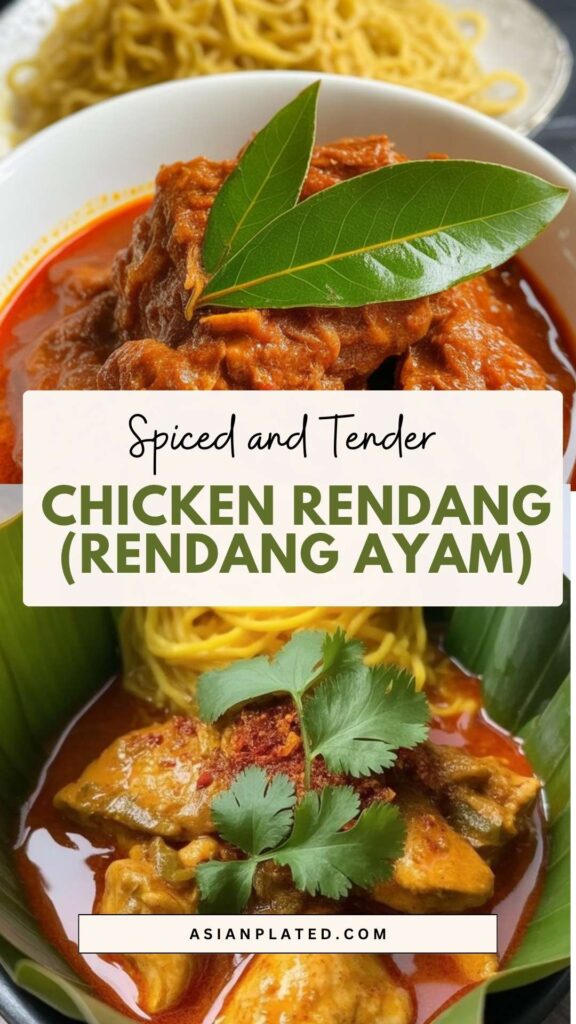
Tips From My Kitchen
- Don’t rush the spice paste – Take your time cooking it. You want it to deepen in flavor and lose its rawness.
- Fresh coconut matters – If you can get freshly grated coconut, use it. The texture and flavor make all the difference in kerisik.
- Low and slow – Keep the heat low after adding the coconut milk. This helps the chicken stay tender and lets the flavors really meld.
- Make extra – Rendang always tastes better the next day. The flavors deepen overnight, making leftovers something to look forward to.
Can You Make It Ahead? Yes, and You Should
This is the kind of dish that’s even better the next day. I often make it in the evening and reheat it for lunch the next day — the sauce thickens, and the chicken becomes even more flavorful.
If you’re meal-prepping or planning for a gathering, make it a day in advance and store it in the fridge. Reheat gently over low heat with a splash of water if needed.
Serving Ideas
I usually serve this with:
- Steamed jasmine or coconut rice
- Roti canai or paratha
- Roti jala (lace pancake), if I have time to make it
- Or just good ol’ basmati rice
It’s one of those dishes that works for both weekday dinners and special weekend meals. And yes, it freezes well too!
Storage Notes
- Fridge: Keeps well for up to 4 days in an airtight container.
- Freezer: Store in a freezer-safe container for up to 2 months. Let it thaw in the fridge overnight and reheat over the stove.
Chicken Rendang (Rendang Ayam)
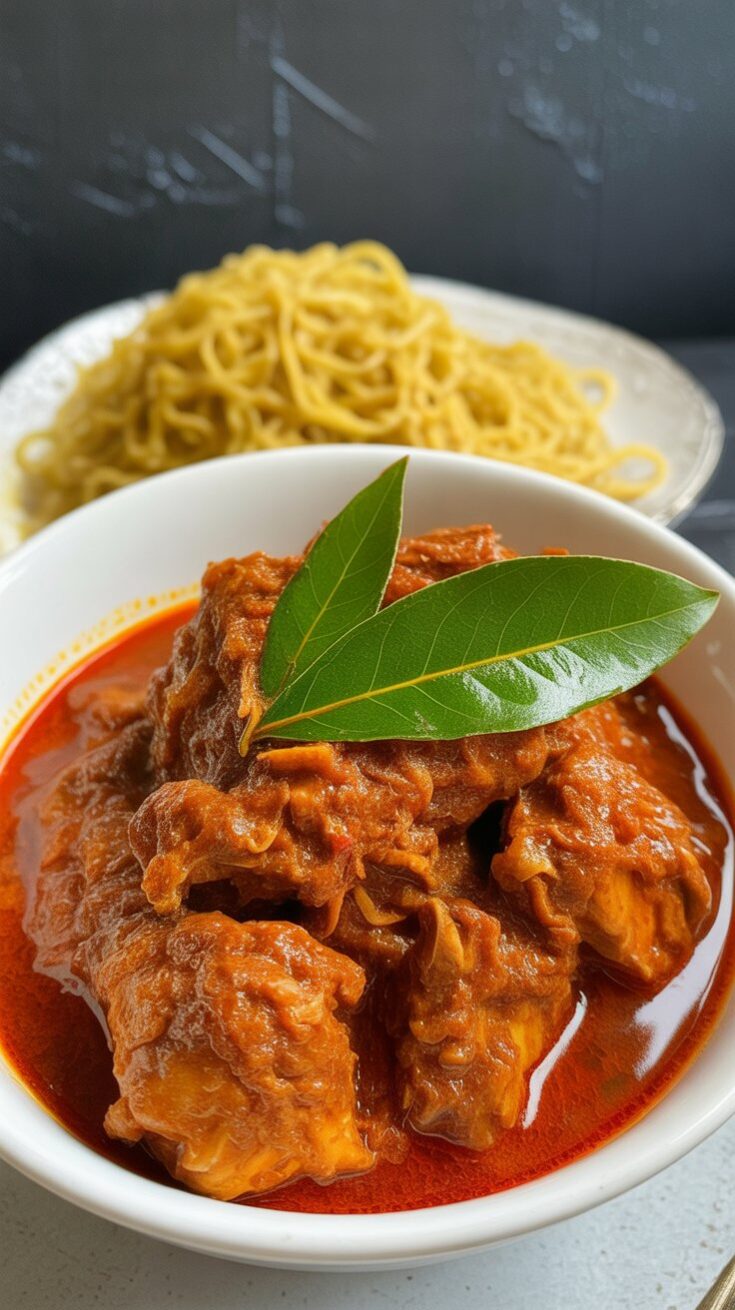
This Chicken Rendang is one of those dishes that fills your kitchen with bold, cozy aromas—spicy, coconutty, and deeply flavorful. The chicken is slow-cooked until it’s tender and coated in a rich, caramelized spice paste, all brought together with creamy coconut milk and toasted coconut.
Ingredients
For the Spice Paste:
- 10 Kashmiri red chilies (soaked in hot water)
- 6 cloves garlic
- 8 small shallots
- 1-inch piece galangal
- 1-inch piece ginger
- 1 stalk lemongrass (use the tender white part)
For the Chicken:
- 500g bone-in chicken pieces
- 1 stalk lemongrass (bruised)
- 1 cup thick coconut milk
- ½ cup water
- 2 kaffir lime leaves
- Salt to taste
- 1 teaspoon sugar
For Toasted Coconut (Kerisik):
- ½ cup freshly grated coconut
Tempering Spices:
- 4 tablespoons oil
- 4 cloves
- 4 green cardamom pods
- 1 stick cinnamon
- 1 star anise
Instructions
- Start by preparing the toasted coconut. If you're using fresh coconut like I do, pulse it in a blender just until it’s finely ground—no water needed. Toast it in a dry pan over low heat, stirring often, until it turns golden brown and fragrant. Set it aside for later.
- Next, make your spice paste. Blend the soaked red chilies, garlic, shallots, galangal, ginger, and lemongrass into a smooth paste. Add a splash of water if needed to help it come together.
- Heat the oil in a large pan or wok over medium heat. Toss in the cloves, cardamom, cinnamon, and star anise. Let them sizzle for a few seconds until aromatic, then stir in the spice paste. Cook this mixture until the oil starts to separate from the paste—this will take around 3 to 4 minutes.
- Add in the chicken pieces and a pinch of salt. Stir well to coat the meat with the paste, and let it cook for a couple of minutes.
- Pour in the bruised lemongrass, coconut milk, and water. Stir, then cover the pan and simmer on low heat for about 20 minutes, or until the chicken is nearly cooked through.
- Once the chicken is tender, stir in the toasted coconut, kaffir lime leaves, and sugar. Cover again and let it simmer for another 10 minutes, allowing the sauce to thicken and the flavors to deepen.
- Serve it hot with steamed rice, roti, or even coconut rice if you're feeling fancy. It’s the kind of dish that only gets better as it sits—so save some for the next day if you can!
Nutrition Information:
Yield: 3 Serving Size: 1Amount Per Serving: Calories: 925Total Fat: 55gSaturated Fat: 24gTrans Fat: 0gUnsaturated Fat: 28gCholesterol: 194mgSodium: 436mgCarbohydrates: 62gFiber: 9gSugar: 24gProtein: 53g
Asianplated.com, occasionally offers nutritional information for recipes contained on this site. This information is provided as a courtesy and is an estimate only. This information comes from online calculators. Although allchickenrecipes.com attempts to provide accurate nutritional information, these figures are only estimates.
Questions You Might Have
Can I use boneless chicken?
You can, but bone-in pieces give a richer flavor and hold up better during the slow cooking. If using boneless, reduce the cooking time slightly.
What if I can’t find galangal?
You can use more ginger in its place. It won’t taste exactly the same, but it’ll still be delicious.
Is this spicy?
It has a mild heat from the red chilies, but you can always adjust by using fewer chilies or a milder variety.
Let me know if you try this version of Chicken Rendang — it’s one of those recipes that turns a simple dinner into something really memorable. And if your kitchen smells amazing afterward, you’re doing it right.
Try other Indonesian recipes:

